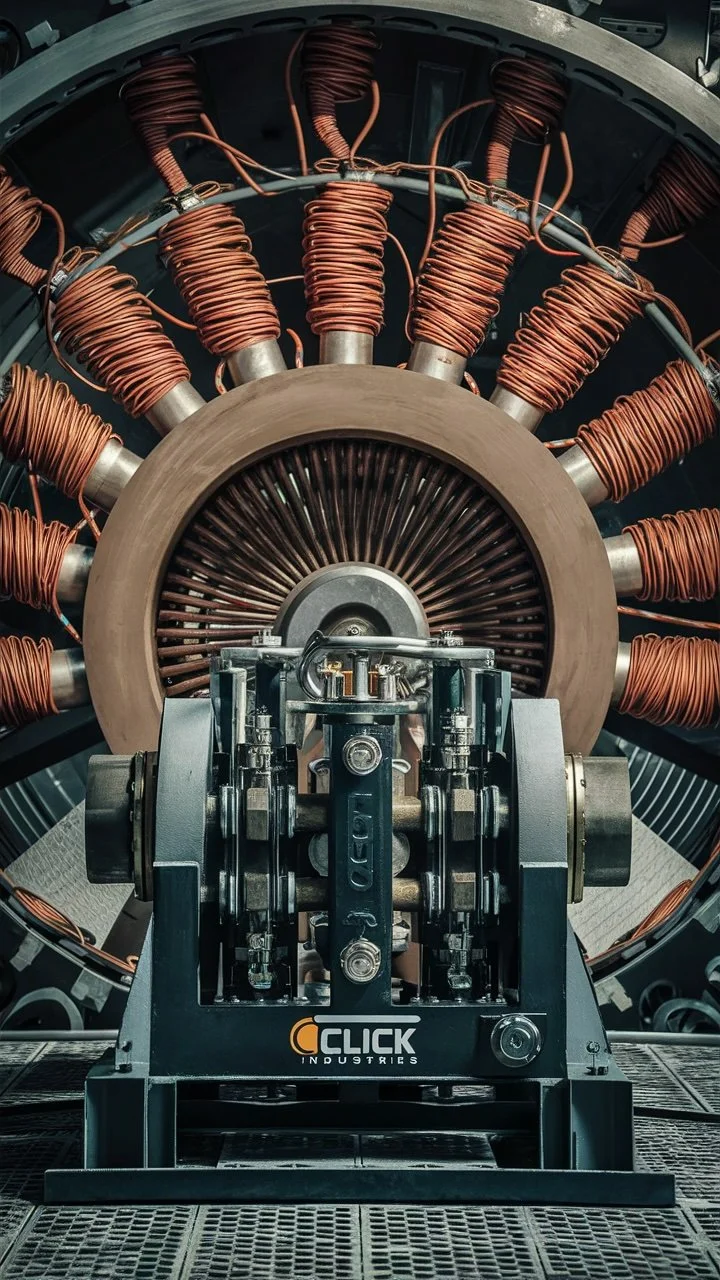Gravy Trolley
Railroad Slang: The term is believed to have originated in the railroad industry in the United States. Railroad workers used the term "gravy train" to describe a run that was easy and highly profitable. The "gravy" part of the phrase likely refers to the ease and abundance of the job, akin to how gravy is seen as a rich and luxurious addition to a meal.
A Power Click
The first magnet used to create electricity was part of an experiment conducted by Michael Faraday in 1831. Faraday discovered that when a magnet is moved through a coil of wire, it induces an electric current in the wire. This phenomenon is known as electromagnetic induction. Faraday's experiments involved using a copper disc that rotated between the poles of a horseshoe magnet, generating a continuous current of electricity. This groundbreaking discovery laid the foundation for the development of electric generators and transformers.
Faraday's work in 1831 was pivotal, marking the first successful attempt to generate electricity using a magnetic field. His experiment demonstrated that a changing magnetic field could produce an electric current, which is the principle behind most modern electrical generators.
Click Eat
One prominent example of the same food being made under both EU and U.S. rules is Kraft Macaroni and Cheese. The product's formulation differs significantly between the two regions due to regulatory and ingredient differences.
Kraft Macaroni and Cheese in the U.S.
Ingredients: The U.S. version often contains artificial dyes such as Yellow 5 and Yellow 6, which give the cheese its bright orange colour. The FDA approves these dyes for use in food, but they have been linked to various health concerns, including hyperactivity in children.
Preservative: It includes preservatives such as sodium phosphate to extend shelf life and maintain the product's texture and appearance.
Nutritional Content: The U.S. version may also contain more sodium and other additives compared to its European counterpart.
Kraft Macaroni and Cheese in the E.U.
Ingredients: The EU version of Kraft "Cheesey Pasta" does not contain the artificial dyes found in the U.S. version. Instead, natural colourants like paprika and beta-carotene are used to achieve the desired colour.
Regulatory Compliance: Due to stricter regulations in the EU regarding food additives and artificial ingredients, the product formulation avoids many of the chemicals allowed in the U.S.
Preservatives: It tends to have fewer preservatives and additives, aligning with the EU's more rigorous food safety and quality standards.
Nutritional Content: The EU version typically has lower sodium levels and may focus more on natural flavours and ingredients.
These differences highlight how regulatory environments influence food manufacturing. In the EU, stricter regulations on food additives and a focus on natural ingredients result in a product with fewer artificial components and potentially healthier nutritional profiles. In contrast, the U.S. version reflects a regulatory environment that allows more artificial additives, which can affect the product's nutritional quality and health implications.
Fête Nat
Bastille Day, celebrated on July 14th, is France's National Day and commemorates several important events and traditions:
1. Storming of the Bastille (1789): The most famous event associated with Bastille Day is the storming of the Bastille prison on July 14, 1789. This marked a turning point in the French Revolution, symbolizing the end of the king's absolute power and the rise of the people's sovereignty. The Bastille was a symbol of the monarchy's tyranny, and its fall became a powerful symbol of freedom and democracy.
2. Fête de la Fédération (1790): The first official celebration of Bastille Day, held on July 14, 1790, was known as the Fête de la Fédération. It commemorated the unity of the French people and the establishment of a constitutional monarchy.
3. Military Parades: One of the key modern traditions of Bastille Day is the military parade held on the Champs-Élysées in Paris. It is the oldest and largest regular military parade in Europe, showcasing France's military strength and honoring its armed forces.
4. Fireman's Ball: An interesting tradition associated with Bastille Day is the Fireman's Ball (Bal des Pompiers), where fire stations open their doors to the public for a night of dancing, music, and festivities.
Centre Click
The youngest winners of the Wimbledon singles titles are:
Men's Singles:
Boris Becker:
- Boris Becker from Germany won Wimbledon in 1985 at the age of 17 years and 227 days. He was the youngest men's singles champion at Wimbledon and also the first unseeded player to win the title.
Women's Singles:
Martina Hingis:
- Martina Hingis from Switzerland won Wimbledon in 1997 at the age of 16 years and 278 days. She became the youngest female singles champion in the Open Era.
Rockets on the Beach
Quartz Sand: This is the most common type of sand found on beaches, especially along coastlines. It's typically light-coloured and composed mainly of silica (silicon dioxide). Quartz sand is durable and resistant to weathering.
Carbonate Sand: Found in tropical and subtropical regions, this sand is composed primarily of calcium carbonate, derived from the shells and skeletons of marine organisms like coral and molluscs. It tends to be white or light-coloured.
Volcanic Sand: Found near volcanic areas, this sand is typically dark-coloured, ranging from black to dark green, and is composed of basalt and other volcanic minerals.
Gypsum Sand: Rare and found in specific locations like White Sands National Park in New Mexico, this type of sand is composed of gypsum crystals. It’s white and very soft.
Olivine Sand: This greenish sand is found in some places with volcanic activity, such as Hawaii. It's rich in the mineral olivine.
Granite Sand: Found near granite outcrops, this type of sand consists of small granite particles. It can range in colour from white to pink to grey.
Coral Sand: Composed of fragments of coral and other marine organisms, this type of sand is common in coral reef areas. It is often light-coloured and can contain bits of shell and other organic material.
Garnet Sand: Rich in garnet minerals, this type of sand can be red or pinkish and is often found in areas with metamorphic rocks.
Clicking Sand
Quartz Sand: This is the most common type of sand found on beaches, especially along coastlines. It's typically light-coloured and composed mainly of silica (silicon dioxide). Quartz sand is durable and resistant to weathering.
Carbonate Sand: Found in tropical and subtropical regions, this sand is composed primarily of calcium carbonate, derived from the shells and skeletons of marine organisms like coral and molluscs. It tends to be white or light-coloured.
Volcanic Sand: Found near volcanic areas, this sand is typically dark-coloured, ranging from black to dark green, and is composed of basalt and other volcanic minerals.
Gypsum Sand: Rare and found in specific locations like White Sands National Park in New Mexico, this type of sand is composed of gypsum crystals. It’s white and very soft.
Olivine Sand: This greenish sand is found in some places with volcanic activity, such as Hawaii. It's rich in the mineral olivine.
Granite Sand: Found near granite outcrops, this type of sand consists of small granite particles. It can range in colour from white to pink to grey.
Coral Sand: Composed of fragments of coral and other marine organisms, this type of sand is common in coral reef areas. It is often light-coloured and can contain bits of shell and other organic material.
Garnet Sand: Rich in garnet minerals, this type of sand can be red or pinkish and is often found in areas with metamorphic rocks.
Click to Start
AT the Panhellenic Games of ancient Greece, as early as the fourth century B.C., runners would crouch and lean forward at the ready, their naked bodies glistening with oil. They were restrained against a premature start by two cords stretched tight across the starting line. One cord held them at their waist and another at the knees.
At the cry of "apite," for "take off," the cords fell forward and the runners broke, sprinting down the track to the cheers of spectators in the stadium. This was the way the highly competitive foot races of Greece began at least as early as 340 B.C., long before there were starting pistols.
Click Lounge
The invention of the match went through several stages, with contributions from various inventors over time. The modern friction match was invented by John Walker, an English chemist, in 1827. Walker's matches, known as "Friction Lights," were made by coating the end of a small wooden stick with a mixture of antimony sulfide, potassium chlorate, gum, and starch. The match would ignite when struck against a rough surface.
However, earlier forms of matches existed before Walker's invention:
1. Chinese Matches (circa 577 AD): The earliest recorded matches were used in China. These were made from small sticks of pinewood impregnated with sulfur.
2. Robert Boyle (1680): Irish physicist Robert Boylediscovered that rubbing phosphorus and sulfur together could create a flame. However, this was not developed into a practical match.
3. Jean Chancel (1805): A French chemist, Jean Chancel, created an early match by coating a wooden stick with a mixture of potassium chlorate, sulfur, sugar, and rubber. This match was ignited by dipping it into sulfuric acid, making it impractical for widespread use.
John Walker's invention marked the beginning of the modern match, which was later improved by others, such as Gustaf Erik Pasch and Johan Edvard Lundström, who developed the safety match in the mid-19th century.
Click, Click, Click
Isaac Beeckman, wrote in 1620 ”A day or two later I received a letter from my father, in which he wrote to me that DREBBEL had developed a boat in England, with which he could sail above and below water as he wished.
The first real submarine capable of operating underwater was tested by Cornelis Drebbel, a Dutch inventor and engineer. Drebbel's submarine was built in the early 17th century, around 1620-1624, under the patronage of King James I of England.
Drebbel's submarine was a wooden vessel covered in greased leather to make it watertight. It was propelled by oars that extended through waterproof seals, allowing it to move underwater. The vessel reportedly made several successful test dives in the River Thames, with Drebbel piloting the submarine on at least one occasion. These tests demonstrated the feasibility of underwater navigation, making Drebbel's submarine the first documented operational submarine in history.
Card Click
The card game Gin, also known as Gin Rummy, was invented by Elwood T. Baker and his son, C. Graham Baker, in 1909. Elwood T. Baker was a teacher of whist, a predecessor of bridge, and his son was a screenwriter in Hollywood. The game was developed as a faster variant of the older game Rummy, which was popular at the time. Gin Rummy quickly gained popularity in the United States, particularly during the early 20th century, and has remained a beloved card game ever since.
Click Corner
Approximately 827,000 people in the United States have July 4th as their birthday. This estimate is based on the average number of births per day in the U.S., which is about 11,000, and the distribution of birth dates throughout the year. Since July 4th is a specific date, this number gives a rough estimate of how many people share this Independence Day birthday.
Click Time
The wind-up alarm clock, an important invention in the history of timekeeping, was first patented by Levi Hutchins of Concord, New Hampshire, in 1787.
However, Hutchins' clock was quite basic, designed to ring only at 4 a.m. to wake him for work and not adjustable for other times.The first adjustable mechanical alarm clock is credited to Antoine Redier, a French inventor, who patented his design in 1847. Redier's invention allowed users to set the alarm to ring at different times, making it more practical and versatile for everyday use. This innovation laid the groundwork for the modern wind-up alarm clocks that became popular in the 19th and 20th centuries.
Happy Birthday
Approximately 827,000 people in the United States have July 4th as their birthday. This estimate is based on the average number of births per day in the U.S., which is about 11,000, and the distribution of birth dates throughout the year. Since July 4th is a specific date, this number gives a rough estimate of how many people share this Independence Day birthday.
Breakfast Negotiations
In the United States, it is estimated that over 10 billion donuts are consumed annually.
Early Origins:
The concept of frying dough is ancient. Archaeological evidence suggests that prehistoric Native Americans made similar fried cakes. In Europe, the Dutch are credited with introducing "olykoeks" (oil cakes), which were dough balls fried in pork fat, in the early 17th century. These early donuts lacked the now-iconic hole in the center.
Arrival in America:
Dutch settlers brought olykoeks to America in the 19th century. The term "doughnut" was first mentioned in an American cookbook in 1803. Legend has it that the hole was introduced by Hanson Gregory, an American ship captain, in 1847. Gregory claimed to have punched a hole in the dough to ensure even cooking and to eliminate the uncooked center that often plagued earlier versions.
Evolution and Popularity:
By the early 20th century, donuts had become a popular American treat. The invention of the donut machine by Adolph Levitt in 1920 revolutionized production, making donuts more accessible and standardized. Donut shops began to spring up across the United States, with chains like Dunkin' Donuts (founded in 1950) further popularizing the treat.
Modern Day:
Today, donuts come in a wide variety of flavors, shapes, and styles. From the classic glazed donut to gourmet versions filled with exotic ingredients, the donut remains a versatile and enduring symbol of indulgence. It is celebrated annually on National Donut Day, observed on the first Friday of June, honoring its cultural and culinary significance.
Click on the Range
The largest cattle drive in history is often attributed to the drive conducted by Charles Goodnight and Oliver Loving in 1866. This drive, known as the Goodnight-Loving Trail, was a significant event in the history of the American West and the cattle industry.
Key Facts about the Drive:
Origin and Destination: The cattle drive began in Texas and aimed to reach Fort Sumner in New Mexico, covering approximately 2,000 miles.
Number of Cattle: While exact numbers are hard to pin down, it is estimated that they drove around 2,000 to 3,000 head of cattle during this journey.
Click Cones
In 1940 Charles B. Scanlon, a painter for the Los Angeles Streets Department designed a hollow cone-shaped marker to keep cars away from wet paint.
Stream
The jet stream refers to narrow, fast-flowing air currents found in the Earth's atmosphere, typically at high altitudes near the tropopause (the boundary between the troposphere and the stratosphere). These ribbons of strong winds can extend thousands of kilometers in length and are crucial in influencing weather patterns and aviation routes.
Putin on the Click
Vladimir Putin's height is generally reported to be around 5 feet 7 inches (170 cm).
A political sociopath is a term used to describe an individual in the political sphere who exhibits traits commonly associated with sociopathy or Antisocial Personality Disorder (ASPD). These traits include a lack of empathy, manipulativeness, deceitfulness, impulsivity, and a propensity for violating social norms and the rights of others without remorse. When applied to a political context, such individuals might use their position and influence to exploit others, manipulate public perception, and pursue their own interests at the expense of ethical standards and the common good.
Click Gas
In 2022, the United States consumed approximately 135.73 billion gallons of gasoline, averaging about 368.63 million gallons per day. This makes gasoline the most consumed transportation fuel in the country.
Regarding the cost, the average retail price of gasoline in 2023 was around $3.40 per gallon. Given this price, the total annual expenditure on gasoline in the U.S. would be approximately $461.48 billion.





















